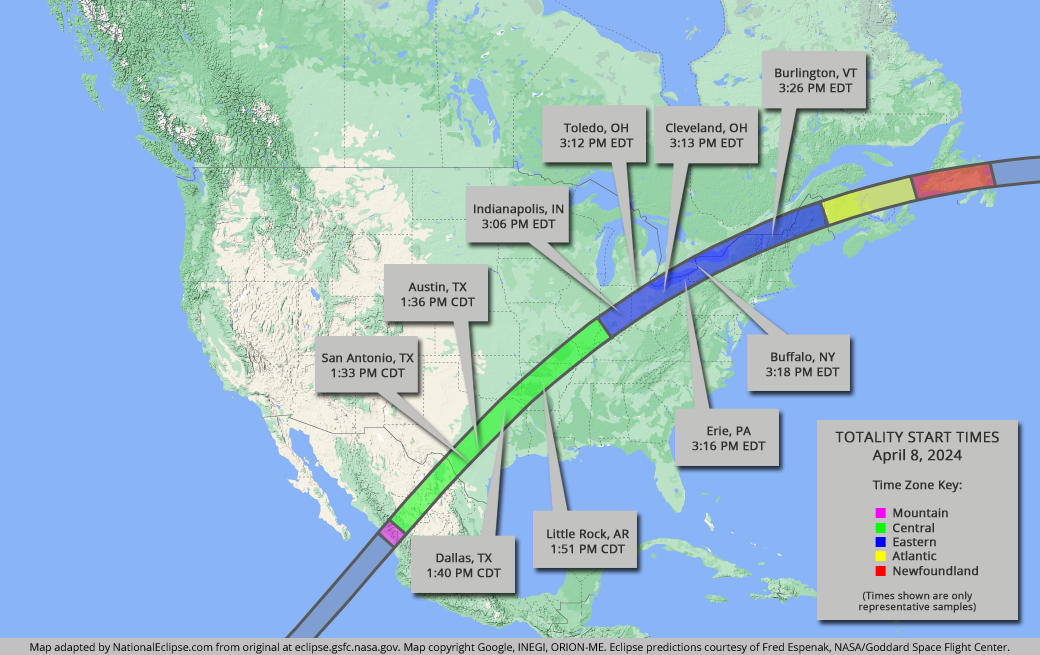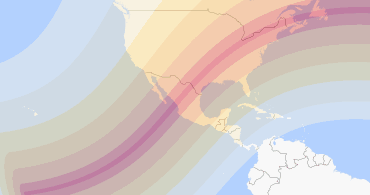Time to make plans to view April 8th 2024 total solar eclipse
The path of the total solar eclipse passes west of the Mississippi River and north of the Ohio River.
The Total Solar Eclipse of 2024 is only four months away. Make your plans now!
On April 8, 2024, the moon will temporarily block all sunlight on a swath of Earth through parts of the United States.
Areas in the path of totality will see the sky darken briefly as if it were dawn or dusk. This can make the temperature drop quickly in just a matter of minutes.
The path of the eclipse brings it into the United State through Texas, and out of the U.S. through Maine. Many major cities are in the path of totality. Nashville and Memphis will only see a partial solar eclipse.
Kelly Korreck, the NASA Program Manager for the 2024 Total Solar Eclipse, says this will be the most populated eclipse in the U.S. with nearly 32 million people just able to walk out of their home and experience the eclipse.
The next total solar eclipse in the U.S. won’t come until 2044 and will only be visible from Greenland to South Dakota. The last total solar eclipse was in 2017. No two eclipses take the same path.
Because of the rarity of the event, and the amount of people traveling from across the country and other parts of the world to see the eclipse, it is wise to start booking your accommodations and travel sooner than later.
Due to high demand, hotel rooms, Airbnbs, and other vacation rental prices are likely to increase dramatically the closer we get to April. Planning a trip now can give you a peace of mind, security, and can save you money.

As a reminder, if viewing the eclipse, you should have ISO-certified-safe solar eclipse glasses and viewers. Viewing an eclipse with the naked eye can cause permanent damage to your eye sight. source
What’s the big deal about the April 2024 total solar eclipse? Why it’s so interesting.
The sky is filled with breathtaking wonders, but one occurring on April 8 is causing people to plan trips in droves, prompting fears of snarled highways and generating headline after headline.
The total solar eclipse on April 8 is causing such a stir because the rare event — where the shadow of the moon will plunge a narrow strip of land into darkness in the middle of the day — is an astronomical experience like no other that will be unusually accessible to millions of people.
April’s total solar eclipse will fall over more places in the U.S. than the total eclipse before and after it. And the broad length of the path of totality – where Americans have the best shot of getting a clear view – is “much wider” than it was for the eclipse in 2017, according to the National Aeronautics and Space Administration.
A total solar eclipse is also far more impressive than a lunar or an annular solar eclipse. During an annular eclipse, the moon covers the Sun but leaves an outside ring some call a “ring of fire” — it darkens the sky instead of plunging Earth into a night-like darkness, which is what happens during a total solar eclipse. And a lunar eclipse – the appearance of a red moon – happens when the moon passes into the Earth’s shadow, according to NASA.
“The eclipse in 2024 could be even more exciting due to differences in the path, timing, and scientific research,” reads a post from NASA. And like past similar natural phenomena, the eclipse is expected to elicit a strong emotional reaction from the people who see it, including from those who identify with its cultural significance.
Total solar eclipses over the US are rare: The next one won’t happen for 20 years
The next visible total solar eclipse to cross over the U.S. after April will come in more than two decades on Aug. 23, 2044, according to NASA.
And that eclipse won’t be as accessible as the 2024 one: The path of totality in 2044 will only touch the states of Montana, North Dakota and South Dakota, according to the Planetary Society, a nonprofit involved in research, public outreach and political space advocacy. Another total eclipse will pass over the U.S. in 2045 that will be more accessible to Americans, including for people who live in California, Florida and Nevada.
Solar eclipses are rare in part because they can only occur during a new moon and when “the moon’s orbit is tilted five degrees to Earth’s orbit around the Sun,” according to the National Weather Service.
This eclipse will pass over millions of people and be a short drive for millions more
NASA estimates 215 million adults in the U.S. saw the 2017 solar eclipse either in person or electronically and even more people will likely see April’s eclipse.
The eclipse’s path of totality will pass over cities like Dallas, Cleveland and Buffalo, New York. And those places will attract sky gazers from all over the country.
Searches for short-term Airbnb rentals around those areas have surged. Transportation officials in areas along the path of totality are warning residents and travelers that the eclipse could create dangerous and busy traffic conditions on roads around places with the best view. source
April 8, 2024 — Great North American Eclipse (Total Solar Eclipse)
The path of totality for this total solar eclipse runs through Mexico, the United States, and Canada.
What happens during a total solar eclipse?
Our timeanddate team will be broadcasting the eclipse LIVE from the USA.
This eclipse is visible in Santa Clarita – go to local timings and animation
Where to See the Eclipse
Path of the Eclipse Shadow
Regions seeing, at least, a partial eclipse: West in Europe, North America, North in South America, Pacific, Atlantic, Arctic.
Eclipse Shadow Path
When the Eclipse Happens Worldwide — Timeline
The eclipse starts at one location and ends at another. The times below are actual times (in UTC) when the eclipse occurs. This calculation uses a Delta T value of 69.2 seconds.
| Eclipse Stages Worldwide | UTC Time | Local Time in Santa Clarita* |
|---|---|---|
| First location to see the partial eclipse begin | Apr 8 at 15:42:15 | Apr 8 at 8:42:15 am |
| First location to see the full eclipse begin | Apr 8 at 16:38:52 | Apr 8 at 9:38:52 am |
| Maximum Eclipse | Apr 8 at 18:17:21 | Apr 8 at 11:17:21 am |
| Last location to see the full eclipse end | Apr 8 at 19:55:35 | Apr 8 at 12:55:35 pm |
| Last location to see the partial eclipse end | Apr 8 at 20:52:19 | Apr 8 at 1:52:19 pm |
* These local times do not refer to a specific location but indicate the beginning, peak, and end of the eclipse on a global scale, each line referring to a different location. Please note that the local times for Santa Clarita are meant as a guideline in case you want to view the eclipse via a live webcam.
Countries Where the Eclipse Is Visible
| Country | Type | Start | End | Totality Duration |
|---|---|---|---|---|
| Canada |
Total Solar Eclipse |
10:40 am PDT | 6:18 pm NDT | 34m, 4s |
| Mexico |
Total Solar Eclipse |
9:32 am PDT | 2:56 pm EST | 40m, 43s |
| United States |
Total Solar Eclipse |
6:27 am HST | 4:41 pm EDT | 1h, 7m, 58s |
| American Samoa |
Partial Solar Eclipse |
6:20 am SST | 6:33 am SST | — |
| Anguilla |
Partial Solar Eclipse |
2:48 pm AST | 4:01 pm AST | — |
| Antigua and Barbuda |
Partial Solar Eclipse |
2:58 pm AST | 3:57 pm AST | — |
| Aruba |
Partial Solar Eclipse |
2:46 pm AST | 3:20 pm AST | — |
| Belize |
Partial Solar Eclipse |
11:13 am CST | 2:47 pm EST | — |
| Bermuda |
Partial Solar Eclipse |
3:26 pm ADT | 5:37 pm ADT | — |
| British Virgin Islands |
Partial Solar Eclipse |
2:44 pm AST | 4:02 pm AST | — |
| Cabo Verde |
Partial Solar Eclipse |
6:49 pm CVT | 6:55 pm CVT | — |
| Caribbean Netherlands |
Partial Solar Eclipse |
2:53 pm AST | 3:56 pm AST | — |
| Cayman Islands |
Partial Solar Eclipse |
12:40 pm EST | 2:58 pm EST | — |
| Colombia |
Partial Solar Eclipse |
12:39 pm COT | 2:35 pm COT | — |
| Cook Islands |
Partial Solar Eclipse |
6:34 am CKT | 7:36 am CKT | — |
| Costa Rica |
Partial Solar Eclipse |
11:18 am CST | 1:24 pm CST | — |
| Cuba |
Partial Solar Eclipse |
1:31 pm CDT | 4:07 pm CDT | — |
| Curaçao |
Partial Solar Eclipse |
3:01 pm AST | 3:09 pm AST | — |
| Dominica |
Partial Solar Eclipse |
3:18 pm AST | 3:35 pm AST | — |
| Dominican Republic |
Partial Solar Eclipse |
2:15 pm AST | 4:04 pm AST | — |
| Ecuador |
Partial Solar Eclipse |
10:57 am GALT | 12:43 pm GALT | — |
| El Salvador |
Partial Solar Eclipse |
11:09 am CST | 1:34 pm CST | — |
| Faroe Islands |
Partial Solar Eclipse |
7:51 pm WEST | 8:36 pm WEST | — |
| France |
Partial Solar Eclipse |
8:58 pm CEST | 8:58 pm CEST | — |
| French Polynesia |
Partial Solar Eclipse |
5:42 am TAHT | 8:16 am MART | — |
| Greenland |
Partial Solar Eclipse |
5:39 pm | 7:37 pm | — |
| Guadeloupe |
Partial Solar Eclipse |
3:07 pm AST | 3:47 pm AST | — |
| Guatemala |
Partial Solar Eclipse |
11:03 am CST | 1:44 pm CST | — |
| Haiti |
Partial Solar Eclipse |
2:06 pm EDT | 4:04 pm EDT | — |
| Honduras |
Partial Solar Eclipse |
11:12 am CST | 1:47 pm CST | — |
| Iceland |
Partial Solar Eclipse |
6:48 pm GMT | 8:29 pm GMT | — |
| Ireland |
Partial Solar Eclipse |
7:54 pm IST | 8:29 pm IST | — |
| Isle of Man |
Partial Solar Eclipse |
7:55 pm BST | 8:06 pm BST | — |
| Jamaica |
Partial Solar Eclipse |
12:51 pm EST | 2:55 pm EST | — |
| Kiribati |
Partial Solar Eclipse |
6:11 am LINT | 7:44 am LINT | — |
| Montserrat |
Partial Solar Eclipse |
3:02 pm AST | 3:50 pm AST | — |
| Nicaragua |
Partial Solar Eclipse |
11:16 am CST | 1:39 pm CST | — |
| Norway |
Partial Solar Eclipse |
8:49 pm CEST | 10:12 pm CEST | — |
| Panama |
Partial Solar Eclipse |
11:35 am CST | 2:16 pm EST | — |
| Pitcairn Islands |
Partial Solar Eclipse |
7:51 am PST | 9:21 am PST | — |
| Portugal |
Partial Solar Eclipse |
7:01 pm AZOST | 8:36 pm AZOST | — |
| Puerto Rico |
Partial Solar Eclipse |
2:32 pm AST | 4:00 pm AST | — |
| Russia |
Partial Solar Eclipse |
9:50 pm MSK | 10:20 pm MSK | — |
| Saint Kitts and Nevis |
Partial Solar Eclipse |
2:56 pm AST | 3:55 pm AST | — |
| Saint Martin |
Partial Solar Eclipse |
2:51 pm AST | 3:59 pm AST | — |
| Saint Pierre and Miquelon |
Partial Solar Eclipse |
4:35 pm PMDT | 6:47 pm PMDT | — |
| Sint Maarten |
Partial Solar Eclipse |
2:52 pm AST | 3:58 pm AST | — |
| Spain |
Partial Solar Eclipse |
9:01 pm CEST | 8:33 pm WEST | — |
| St. Barts |
Partial Solar Eclipse |
2:53 pm AST | 3:58 pm AST | — |
| Svalbard and Jan Mayen |
Partial Solar Eclipse |
— | — | — |
| The Bahamas |
Partial Solar Eclipse |
1:48 pm EDT | 4:18 pm EDT | — |
| Tokelau |
Partial Solar Eclipse |
6:29 am TKT | 6:35 am TKT | — |
| Turks and Caicos Islands |
Partial Solar Eclipse |
2:10 pm EDT | 4:10 pm EDT | — |
| US Minor Outlying Islands |
Partial Solar Eclipse |
5:38 am | 2:56 pm | — |
| US Virgin Islands |
Partial Solar Eclipse |
2:43 pm AST | 4:00 pm AST | — |
| United Kingdom |
Partial Solar Eclipse |
7:52 pm BST | 8:51 pm BST | — |
| Venezuela |
Partial Solar Eclipse |
1:38 pm COT | 3:41 pm VET | — |
All times shown in this table are local time. (Note: more than one time zone is listed.) “Totality duration” gives the time between the start and finish of totality within the entire country (not at one location).
How Many People Can See This Eclipse?
| Number of People Seeing… | Number of People* | Fraction of World Population |
|---|---|---|
| Any part of the eclipse | 652,000,000 | 8.19% |
| At least 10% partial | 608,000,000 | 7.63% |
| At least 20% partial | 568,000,000 | 7.12% |
| At least 30% partial | 533,000,000 | 6.70% |
| At least 40% partial | 489,000,000 | 6.14% |
| At least 50% partial | 445,000,000 | 5.59% |
| At least 60% partial | 402,000,000 | 5.04% |
| At least 70% partial | 369,000,000 | 4.64% |
| At least 80% partial | 294,000,000 | 3.69% |
| At least 90% partial | 193,000,000 | 2.43% |
| Totality or annularity | 43,800,000 | 0.55% |
* The number of people refers to the resident population (as a round number) in areas where the eclipse is visible. timeanddate has calculated these numbers using raw population data provided by the Center for International Earth Science Information Network (CIESIN) at Columbia University. The raw data is based on population estimates from the year 2000 to 2020. source
What time is solar eclipse in Los Angeles?
LOS ANGELES – A total solar eclipse crossed North America today, slicing a diagonal line from the southwest to the northeast, briefly plunging communities in Mexico, the U.S. and Canada along the track into darkness.
Outside that narrow path, the eclipse was still visible in different parts of the U.S., including California, but the moon only partially obscured the sun. Think of it this way — the further away from the path of totality, the slighter the partial eclipse was.
According to calculations by NASA, areas to the south and east of Los Angeles saw about 50% obscuration—the moon shrouding half of the sun—while much of the rest of the state saw around 25%.
The best spot to see the most coverage in the Golden State was estunated to be near Holtville in Imperial County, where nearly 59% obscuration was predicted, reaching a maximum effect around 11:14 a.m. PST, according to forecasts by meteorological and astronomical data compilers Time and Date.
San Diego was expected to see 53.8% coverage, per NASA calculations, around 11:11 a.m. PST, while Los Angeles was expected to see 48.6% obscuration around 11:12 a.m.
There were several watch parties around the Los Angeles area to celebrate the rare phenomenon.


